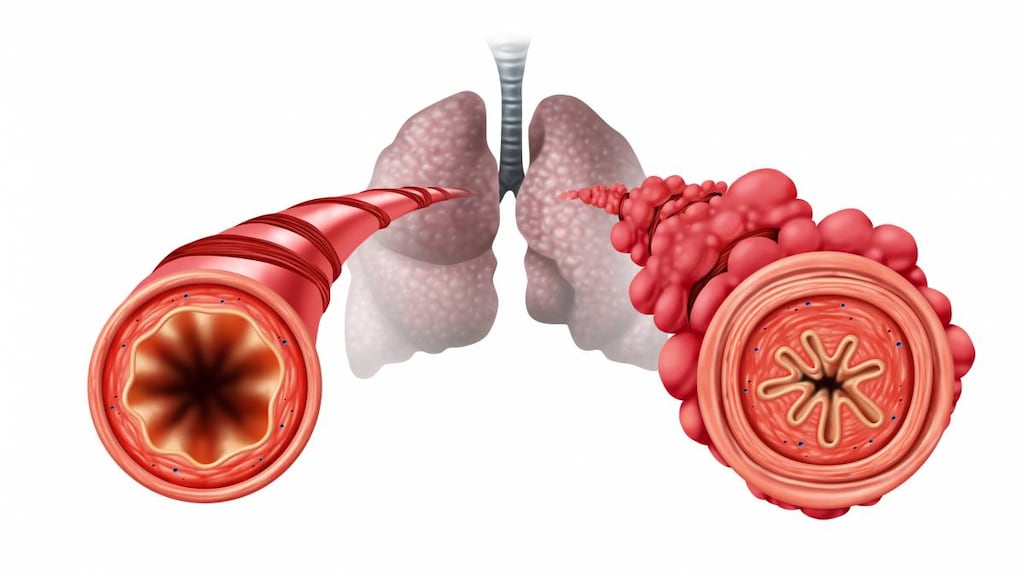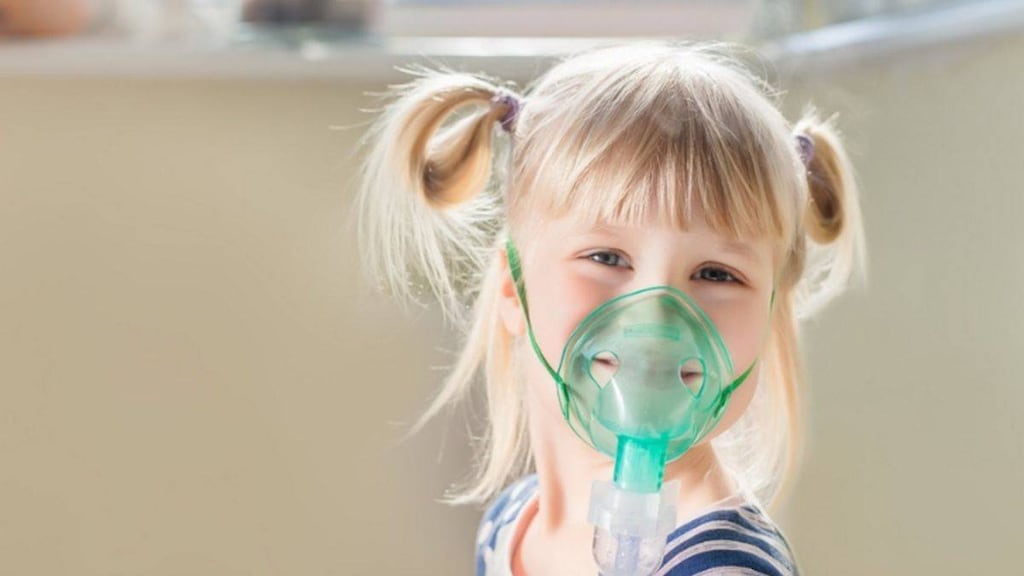Vaping and Popcorn Lung

Many of the negative effects of vaping involve damage to the lungs. That includes one consequence you might not have heard of.
It's bronchiolitis obliterans — informally called “popcorn worker’s lung” or “popcorn lung” — and it's a debilitating type of lung disease. Popcorn lung occurs as a result of scarring in the bronchioles, the small airways of the lungs. The scarring itself is caused by some form of injury to the lungs, which in turn causes the airways to narrow, interfering with air flow and making it difficult to breathe.
This injury of the lungs is typically caused by breathing in dangerous chemicals or fumes. One culprit implicated in the condition is diacetyl, an ingredient that used to be included in the manufacturing of popcorn products to give it a buttery flavor — thus its nickname — and is now included in many e-cigarettes. While manufacturers of popcorn removed diacetyl from their products after it was linked to popcorn lung in workers who inhaled the chemical, this has not been the case with e-cigarette makers. Researchers at the Harvard T.H. Chan School of Public Health in Boston found that 75 percent of flavored e-cigarettes and refill liquids contain diacetyl.
The U.S. Food and Drug Administration (FDA) has banned the sale of certain flavored e-cigarettes to minors.
Other causes and symptoms of popcorn lung
In addition to being caused by inhaling toxic fumes, including those containing diacetyl, popcorn lung can stem from several other things. One of the most common causes is an infection from a virus called adenovirus, according to the Children’s Hospital at Vanderbilt University. Other illnesses linked to popcorn lung include influenza, parainfluenza, varicella, measles, respiratory syncytial virus (RSV), mycoplasma (a bacterium), rheumatologic diseases and other autoimmune responses. It can also result from a drug reaction.
It can take weeks before symptoms of popcorn lung appear. The most common symptom is shortness of breath. Others include coughing, wheezing, fatigue and a crackling sound when breathing in.
Teens, vaping and popcorn lung: a toxic combination
The report of a Canadian teen who experienced life-threatening bronchiolitis from e-cigarette use, published in the Canadian Medical Association Journal, made the connection between vaping and popcorn lung. The case adds to a growing consensus among medical experts and regulators that flavored e-cigarettes are highly dangerous to young people and access to these devices should be regulated and restricted.
There are numerous worrisome issues surrounding e-cigarettes, and the flavored ones in particular. For one, they are very popular with teens. A study published in the November 2019 edition of Pediatrics reported that teens who vape using nontraditional flavors — fruit, candy, dessert and buttery flavors, for example — are more prone to continue vaping, and they inhale more per vape session and take more puffs than those who vape with traditional flavors. Teens vaping with nontraditional flavors are also more likely to continue the habit, the study found.
Concern over e-cigs is accelerating right along with the popularity of vaping among teens. For example, according to data from the National Youth Tobacco Survey, the number of teens who said they used e-cigarettes in the last month climbed 75 percent in one one-year period alone. The survey also found that approximately 20 percent of high school students vape.
A survey conducted by The Wall Street Journal and Mercury Analytics found that nearly one-third of teens vape, and more than 50 percent of those who vape do so because they think it’s fun, enjoy the many nontraditional e-liquid flavors available and believe vaping can be part of a healthy lifestyle.
Of significant concern is that vaping may be a gateway to smoking cigarettes. According to the Partnership for Drug-Free Kids, a meta-analysis of six studies found that a teen’s risk of smoking increased fourfold if the teen vaped, compared with teens who did not vape. A separate study involving more than 2,000 teens found that 20 percent of those who regularly vaped at the beginning of the study were smoking cigarettes at least three times a month by the end of the study. An additional 12 percent of habitual vape users smoked once a month or more often. By contrast, less than 1 percent of students who did not vape smoked cigarettes.
E-cigarettes are toxic to more than the lungs. While many people are under the impression that vaping is safer than smoking, recent research done at Stanford University suggests that the flavors used in e-cigarettes can cause heart damage in addition to the damage caused by nicotine.
To test these flavors, the research team used stem cells to create endothelial cells, a type of cell found on the inner lining of blood vessels. They then tracked the effects of six e-liquid flavors — cinnamon, fruit, butterscotch, menthol, tobacco and sweet tobacco with caramel and vanilla — on the cells they had created. Many of the e-liquid flavors were found to be toxic to the cells, particularly cinnamon and menthol.
Additional research demonstrated that the e-liquids led to an increase in the production of molecules that damage DNA and can lead to cell death. Some of the flavors also interfered with the cells’ role in the growth of new blood vessels, and some made it difficult for the cells to migrate, compromising their ability to heal wounds.
In some cases, the effects of the e-liquids depended on how much nicotine was included in the liquid, but in others it did not. As senior author of the study Dr. Joseph Wu, pointed out, this is the first time researchers have had data to demonstrate the adverse effects of e-liquids on human endothelial cells, and it clearly shows that e-cigarettes should not be considered a safe alternative to cigarettes.
Vaping: dangerous to all
The reality is that vaping e-cigarettes can be dangerous on many fronts.
Vape devices contain coils that heat up the vaping liquid, typically a mixture of chemicals. The coils transform the liquid into an aerosol mist or vapor that can be inhaled, delivering these chemicals to the lungs and placing users at risk for severe damage to their pulmonary system. In fact, each puff of e-liquid vapor exposes the user to 60 to 100 chemicals that the lungs are unprepared to deal with. So far, medical experts say, none of these chemicals has been properly studied for safety via inhalation.
Inhaling e-liquid vapor also has an immediate adverse effect on vascular function, even when the chemical mix does not contain nicotine, according to the results of a study published in the journal Radiology.
According to the authors of the study, e-liquid vapor contains harmful particles that, once inhaled, can make their way to the alveoli, tiny air sacs in the lungs, and then into the blood vessels. This compromises vascular function and leads to inflammation.
A separate study by researchers at the University of California, San Francisco, reported that use of e-cigarettes notably increases a person’s risk for a variety of chronic lung diseases, including bronchitis, asthma, emphysema and chronic obstructive pulmonary disease (COPD).
The results of the study, published in December 2019 in the American Journal of Preventive Medicine, come from an analysis of data from a study that followed the vaping and tobacco behaviors as well as new diagnoses of lung disease in thousands of American adults over several years. Called the PATH study (for Population Assessment of Tobacco and Health), it was conducted by the U.S. National Institutes of Health and the FDA.
The researchers found that vaping raised the participants’ chances of developing lung disease by approximately one-third, even when taking into account their use of tobacco, medical history and background.
Article references
- Children's Hospital of Vanderbilt, Bronchiolitis Obliterans - https://www.childrenshospitalvanderbilt.org/sites/default/files/drupalfiles/2018-06/bronchiolitis-obliterans.pdf
- American Lung Association, Learn About Bronchiolitis - https://www.lung.org/lung-health-and-diseases/lung-disease-lookup/bronchiolitis/learn-about-bronchiolitis.html
- Pulmonary & Critical Care Medicine Associates, Popcorn Lung and E-Cigarettes - https://www.pccma.net/2018/08/22/popcorn-lung-e-cigarettes/
- Harvard T.H. Chan School of Public Health, Chemicals linked with severe respiratory disease found in common e-cigarette flavors - https://www.hsph.harvard.edu/news/press-releases/e-cigarette-flavoring-chemicals-linked-to-respiratory-disease/
- Canadian Medical Association Journal, “Life-threatening bronchiolitis related to electronic cigarette use in a Canadian youth” - https://www.ncbi.nlm.nih.gov/pubmed/?term=31753841
- American Academy of Pediatrics, Sweet, Fruity E-Cig Flavors Associated with Long-Term/Heavier Vaping Among Teens - https://www.aap.org/en-us/about-the-aap/aap-press-room/pages/Sweet,-Fruity-E-Cig-Flavors-Associated-with-Long-Term-Heavier-Vaping-Among-Teens.aspx
- Journal of the American College of Cardiology, “Modeling Cardiovascular Risks of E-Cigarettes With Human-Induced Pluripotent Stem Cell–Derived Endothelial Cells” - http://www.onlinejacc.org/content/73/21/2722
- Stanford Medicine, “E-cigarette use, flavorings may increase heart disease risk” - https://med.stanford.edu/news/all-news/2019/05/e-cigarette-use-and-flavorings-may-increase-heart-disease-risk.html
- Boston Children's Hospital, Vaping - http://www.childrenshospital.org/conditions-and-treatments/conditions/v/vaping
- UC San Diego News Center, Vaping: A Serious Hit to Your Health - https://ucsdnews.ucsd.edu/feature/vaping-a-serious-hit-to-your-health
- Radiology, “Acute Effects of Electronic Cigarette Aerosol Inhalation on Vascular Function Detected at Quantitative MRI” - https://pubs.rsna.org/doi/full/10.1148/radiol.2019190562
- University of California, San Francisco, E-Cigarettes Significantly Raise Risk of Chronic Lung Disease, First Long-Term Study Finds - https://www.ucsf.edu/news/2019/12/416216/e-cigarettes-significantly-raise-risk-chronic-lung-disease-first-long-term
- Food and Drug Administration, FDA finalizes enforcement policy on unauthorized flavored cartridge-based e-cigarettes that appeal to children, including fruit and mint - https://www.fda.gov/news-events/press-announcements/fda-finalizes-enforcement-policy-unauthorized-flavored-cartridge-based-e-cigarettes-appeal-children
- Partnership for Drug-Free Kids, E-Cigarette Use Spikes Among High School Students - https://drugfree.org/learn/drug-and-alcohol-news/e-cigarette-use-spikes-among-high-school-students/
- Partnership for Drug-Free Kids, The Teen Vaping Trend – What Parents Need to Know - https://drugfree.org/parent-blog/the-teen-vaping-trend-what-parents-need-to-know/



